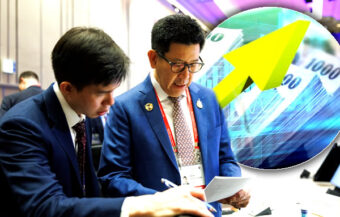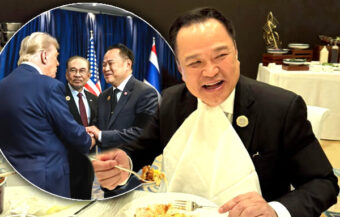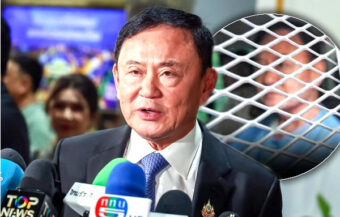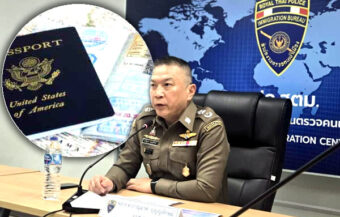Thailand reels from political turmoil and a 4.24% tourism drop as US tariffs on exports threaten to soar from 10% to 36% on July 9. Finance Minister Pichai pushes for a last-minute extension to avert economic shock and protect the nation’s fragile and falling GDP growth rate.
Thailand is reeling from a double blow. A deepening political crisis is rattling investor confidence, stalling budgets and shaking business stability. At the same time, the country is staring down a sharp and unexpected drop in foreign tourism. Figures to June 22 show tourist arrivals down 4.24% compared to last year. It’s a wake-up call for planners—and a warning sign for an economy already on edge. But worse may lie ahead. On July 9, U.S. tariffs on Thai exports are set to soar from 10% to a punishing 36%. America is Thailand’s top export market. The hit could be brutal.
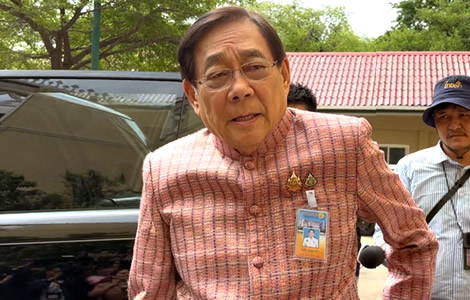
On Tuesday, Finance Minister Pichai struck a note of guarded optimism. He said Thailand is pushing hard for a last-minute extension of the current tariff suspension, giving negotiators more time to seal a deal with U.S. trade officials.
“This isn’t over,” he said. “No country has clinched a final deal yet. But we’re still in the fight.
Thailand is facing a critical moment as it attempts to stave off a steep economic downturn. Finance Minister Pichai Chunhavajira has confirmed that the country is now seeking an official extension from the United States. The aim is to delay the imposition of reciprocal tariffs that are scheduled to rise to 36% on July 9.
Thailand lags behind regional peers as US trade deadline nears and risks to exports intensify
Currently, Thailand—like most nations—faces a 10% baseline tariff. However, without a bilateral deal, that rate will more than triple in less than two weeks. This development could significantly damage the competitiveness of Thai exports to the U.S., which is the kingdom’s largest trading partner.
For that reason, Pichai emphasized that detailed negotiations are underway with the Office of the United States Trade Representative (USTR). The Thai government sent a formal proposal to Washington last week. In the meantime, both sides have signed a non-disclosure agreement to keep the talks confidential.
“We’ve submitted everything necessary. Now we wait,” Pichai told reporters at Government House on Tuesday. “No country has finalized an agreement yet. But we believe Thailand still has a strong chance.”
Nevertheless, Thailand’s trade negotiations have started more slowly than those of its regional peers. Countries like Vietnam and Malaysia began talks earlier and are reportedly closer to final agreements. Even so, Pichai stressed that Washington has yet to finalize deals with any nation, despite President Donald Trump’s looming July 9 deadline.
Global scramble to avoid tariff surge heats up as countries rush to submit final US trade proposals
This deadline, often referred to by U.S. officials as “Liberation Day,” will see steep tariffs imposed on all countries lacking trade agreements. Thailand’s current proposal seeks to extend the negotiation window beyond the original 90-day moratorium. According to Pichai, the U.S. is now assessing whether Thailand’s offer is worth considering for an extension.
Importantly, Thailand is not alone in the rush to secure terms with the U.S. Vietnam, for instance, has proposed increasing purchases of American aircraft and agricultural products.
That offer could result in tariffs capped between 20% and 25%, according to reports. Meanwhile, Malaysia’s Prime Minister Anwar Ibrahim claimed that talks with Washington have gone well. He noted that semiconductors—many of which are exported to the U.S.—are a key focus.
In contrast, Japan and South Korea are still struggling to break through deadlocks. Auto and steel tariffs remain key obstacles for both. For India, agricultural market access continues to be the sticking point. The U.K. remains the only country with a written deal in place. However, that agreement simply preserves the 10% baseline rate and fails to address deeper trade grievances, such as steel tariffs.
Thai exporters brace for hit as US orders slow and new tariff fears begin to shake market confidence
In Thailand’s case, the stakes are unusually high. The country’s export sector accounts for nearly two-thirds of GDP. The United States alone receives around 20% of Thailand’s total outbound shipments. Accordingly, a 36% tariff would likely crush demand for Thai goods in the U.S. market.
Although Pichai expressed confidence, economists are growing anxious. Thai exports surged during the first five months of 2025. Yet that growth was primarily driven by American firms placing advance orders. These companies hoped to beat the anticipated tariff hike. In June, however, exports began to slow. This trend is now triggering concern among analysts and business leaders.
Meanwhile, the tourism sector is also showing signs of distress. The Ministry of Tourism and Sports reported this week that foreign tourist arrivals fell 4.24% year-on-year through June 22. During that period, Thailand welcomed only 16.04 million foreign visitors. That figure came in well below projections and dashed earlier hopes of a strong recovery.
Tourist arrivals plunge as political unrest, border tensions, and missed targets undermine recovery plans
Malaysia led the way in tourist numbers with 2.19 million visitors. China followed closely with 2.17 million, thanks largely to a robust January. Nonetheless, the total number fell short of targets set earlier in the year. In fact, in May, the National Economic and Social Development Council (NESDC) had already revised its tourism forecast downward—from 38 million to 37 million.
It is worth noting that Thailand saw nearly 40 million tourists in 2019, before the COVID-19 pandemic. Although recovery efforts have been underway, multiple factors are now undermining progress. Political instability, in particular, is emerging as a significant deterrent.
Tensions spiked after the leak of a phone call between Prime Minister Paetongtarn Shinawatra and former Cambodian leader Hun Sen. The call revealed growing concerns over border security and possible regional conflict. As a result, Thailand’s border with Cambodia was closed. This move disrupted both trade and tourism in the eastern provinces.
Industry voices deep concern as coup rumours spread and the government struggles to reassure global markets
Moreover, tourism operators have begun to voice alarm about the nation’s political turmoil. Many are warning that even whispers of a coup must be taken seriously. Such instability, they argue, would further damage international confidence and scare off long-haul travellers. These visitors are especially important in the second half of the year, as Thailand aims to meet even its adjusted goals.
“Tourists, especially from Europe and North America, are sensitive to political risk,” said one Bangkok-based hotel executive. “They want assurance. Right now, Thailand doesn’t offer that.”
Additionally, economists warn that if both exports and tourism remain sluggish, GDP growth could fall below 1% in 2025. That would mark one of the weakest expansions in over a decade and could raise questions about the government’s economic strategy.
Meanwhile, Prime Minister Paetongtarn is under increasing pressure to stabilize her coalition. A cabinet reshuffle is currently underway as she attempts to hold her administration together. So far, the reshuffle has done little to calm markets or address underlying structural concerns.
Trade shock and political drift collide as the region seeks stability and Thailand faces growing isolation
At the same time, the broader region is experiencing tremors of its own. For example, China has secured a fragile trade truce with the U.S., valid through mid-August. South Korea, on the other hand, is scrambling for exemptions, particularly for steel and automobiles. Their new trade minister flew to Washington on June 23 to salvage the situation.
Back in Bangkok, Pichai maintains that Thailand’s proposal is credible and has potential. Yet he admitted the final outcome depends on U.S. decisions. “If Washington views our offer as productive, they may grant us an extension,” he said. “We are hopeful, but time is tight.”
So far, companies that export to the U.S. remain in a holding pattern. Some have accelerated shipments. Others have slowed operations, awaiting clarity. In this uncertain climate, many fear that July 9 will bring a tariff shock if no deal or extension is reached.
US attack on Iran and Gulf of Hormuz threats spark fears of an oil price shock and more economic pain
Search for a new central bank boss heats up amid a political and economic storm buffeting the kingdom
Liquidity crisis or shortage of cash on the ground is shrinking Thailand’s economic growth prospects
The impact will be uneven. High-margin electronics and niche products may survive. But bulk exports, especially in agriculture, textiles, and auto parts, could become noncompetitive overnight. That could result in job losses and factory shutdowns.
Undoubtedly, Thailand faces a dual economic threat: a looming tariff deadline and a weakening tourism sector. Both are colliding with a tense political atmosphere that has sapped business confidence. Over the next two weeks, the government must act quickly and decisively. Otherwise, the nation risks sliding into deeper economic trouble by year’s end.
Join the Thai News forum, follow Thai Examiner on Facebook here
Receive all our stories as they come out on Telegram here
Follow Thai Examiner here
Further reading:
Liquidity crisis or shortage of cash on the ground is shrinking Thailand’s economic growth prospects
Thai Minsters engage with US trade chief Jamieson Greer in Paris at global OECD ministerial meeting
Commerce Minister meets US trade boss Jamieson Greer in Korea. Paul Chambers case still dogs talks







